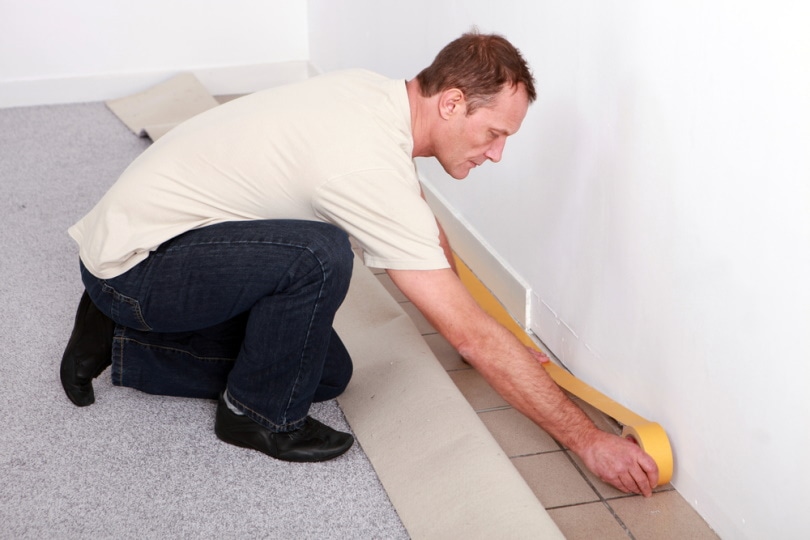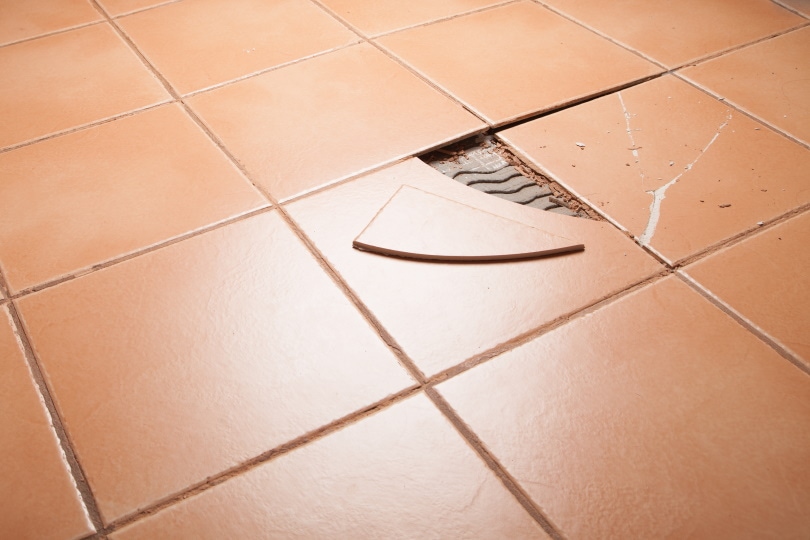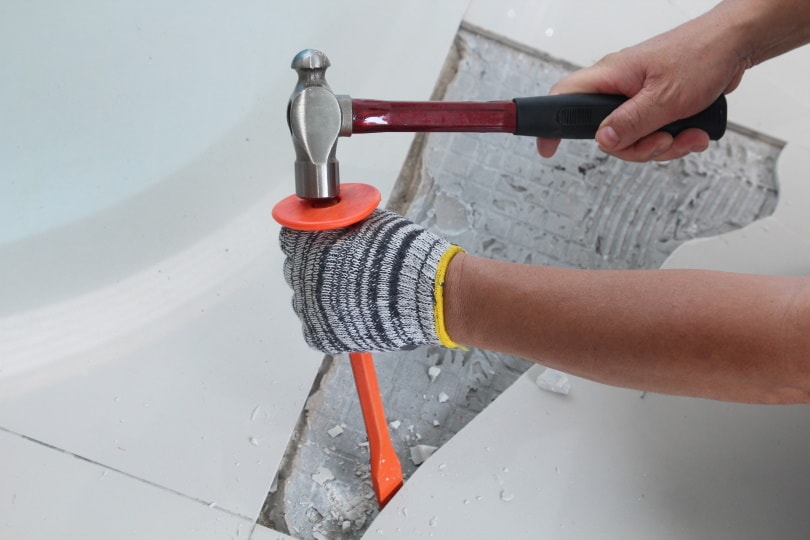Can You Put Carpet Over Tile? Reasons, Benefits & Guide
-
Pete Ortiz
- Last updated:

Since the advent of tile flooring, there have been debates about whether or not people can install a carpet over tiled floors. You can, but professionals and construction and building industry experts have different opinions about the issue.
They all have theories and opinions concerning the advantages and disadvantages of installing a carpet on tiled floors. If you were wondering if you can do it and how to go about it, you have come to the right place. We are going to answer the question and provide insight into information related to tile flooring and carpeting.
So Can I Install a Carpet Over My Tiled Floors?
Of course, you can! There isn’t anything stopping you from installing a carpet over your tiled floors. Carpet installation would come in handy, especially if you have slightly damaged or old tiles that are giving off a bad appearance and are an unpleasant sight. Removing old or damaged tiles and replacing them with new ones is a costly affair.
The cost of buying a new carpet and putting it on your tiled floor is lower than replacing old or damaged tiles. To avoid spending more than you can afford, you can opt to put carpet on them. Additionally, you get to give your room a new and possibly modern look.
However, this doesn’t mean it’s a straightforward process. There are some factors you need to consider before you embark on such a project. For example, you need to find professionals to do the job to avoid common pitfalls associated with such installations. If you are fond of DIY home improvement, you may want to sit this one out.

Is It a Good Idea?
Installing carpet over tiles is a brilliant idea. However, keep in mind that not all tiled floors are fit for tile installation. For instance, carpet installation would not be applicable if the tiles have the following issues:
The 2 Instances When You Can’t Install Carpet Over Tiles
1. Large Distance Between Grout Lines
One situation that may deter you from carpeting a tiled floor is when you have unusually deep and wide grouting. All tile floors have grout lines. These lines vary in distance between one tile and the next.
For example, you may have an enclosed patio with a large terracotta tiled floor. These usually have wide and deep grouting that makes carpeting a nightmare. On the other hand, tiles with 1.5 mm–3 mm grout lines can be carpeted over as long as the floor is in good condition.
So generally, you are discouraged from putting carpet on tile flooring if the grout lines are more than 3mm apart. It’s because these lines are too wide apart and will make the carpet uneven.
2. Drummy/Heavily Damaged Tiles
Drummy tiles are those that have a hollow structure. A drummy tile produces a hollow sound when you tap it with an object such as a pen. The hollow sound is an indication that the tile is faulty, improperly installed, or about to come off.
If you put carpet on drummy or heavily damaged tile flooring, you will end up having an uneven floor and damage your carpet.
But if you must install the carpet, you have to remove all faulty or broken tiles. Fill in the gaps left with quick drying cement or similar substances to even the sub-floor. The EPA (Environmental Protection Agency) has more details on this.
Keep in mind that installing carpeting on a tiled floor means you won’t use the tile floor in the future should you wish to remove the carpet. There will be some damage to the tiles. Additionally, the area where the carpet is nailed down and glued (perimeter tiling) will experience some damage. Basically, your tiled flooring is damaged when you install a permanent carpet and you cannot use it again.
On the upside, carpets can be temporarily placed on tiled floors without installation. There are portable carpets you can use instead of nailing and gluing it to your floor. Such carpets are more of wall-to-wall rugs or rugs that cover a specific area.

Benefits of Installing Carpeting on Tiled Floors
- Increase the Value of Your Property: If you are planning to sell your home or take on a second mortgage, the home has to be valued. When property appraisers are assessing it, they take into consideration everything including the condition of your floors. Worn-out and faded tiles decrease the value of your home. To avoid this, you can put carpet on areas with such tiles. This is a great and affordable way to increase the value of your home.
- Keep Your Home Warm: Some tiles such as ceramic tiles are known to make a house cold. This means you have to heat your home often. To reduce money spent on heating, put a carpet on your tiles. They make a room warmer and prevent your feet from getting cold when you step on the floor.
- Changing Your Home Appearance: Tile flooring is usually permanent and costly to replace. An affordable and less intrusive option is a carpet on tile flooring. There are a plethora of affordable carpet designs that can significantly improve the appearance of your home. Carpets also bring more color to dull rooms.
- Soft Flooring: If you have a child or pet, they may get hurt when they fall on tile flooring. Since this is inevitable, the best option is to put a carpet on the tile. The carpet acts as a padding that minimizes injuries when your pet or child falls on the floor.
How Do You Install Carpet on Tiled Flooring?
Carpet is installed on tiled flooring in the same way it is installed on cement flooring. For starters, it is stretched over the floor and all bumps and humps are smoothened out. Next, the carpet’s smooth edges are aligned with the perimeter of the floor and nailed or glued into the grout. This is done on each side of the floor at the grout line nearest to the wall.
The following procedure will come in handy:
1. Preparation
The installer or you need to remove tiles on the room’s perimeter using a tile cutter to ensure a 2-inch space that’s larger than the width of your tackle strips. This step starts when the tiled floor is cleaned and dry. Now measure the rooms.
Use a hacksaw to get a tackless strip length that coincides with each of the room’s measurements. Make sure you put on safety/construction gloves to work with tackless strips. This is the point you start positioning the strips.
Ensure the tacks’ pointed ends face up as you position the strips around the room. The space between the walls and strips should be approximately 2/3 of the carpet’s thickness. Hammering a minimum of 2 masonry nails in each strip and into the subfloor is the way to go. The corners of the room need a nail added to the joints of the same.

2. Installing Under-Padding and Laying a Carpet
The CRI (Carpet and Rug Institute) has various guidelines for carpet installation. Start by cutting strips of the under-padding making sure they extend over tackle strips at each room’s end. Followed by laying out the under-padding. Ensure it is stapled every six inches along each edge of your room.
Use duct tape to seal where strips overlap with seams. Get a utility knife to trim excess padding at all the ends of the room. Now you can cut the carpet to make sure it is 4–6 inches longer than the dimensions of the room.
When you lay the first piece, it needs to have about 2 inches more at the wall. In case you need two or more carpet pieces to fit, ensure the second piece overlaps the first by approximately two inches.
3. Installing the Carpet
Mark the edge where the bottom carpet overlaps the bottom carpet and snap a chalk line. Use a row cutter to cut the carpet’s bottom using this mark. A strip of seaming tape needs to be laid on each seam. Make sure it’s laid with the adhesive facing you. Melt the adhesive by running a seaming iron on the strip. Press down each of the seams on the adhesive you melted.
Go to one corner of the room and hook the ends of the carpet over the tackle strip. Place a knee kicker approximately an inch from the wall and insert the teeth into your carpet. Use your knee to press on the kicker’s cushioned end. This move ensures the carpet is hooked onto the tackless strip.
Use the location of the wall you hooked the carpet to insert the base of your power stretcher. Insert the teeth of this stretcher into the carpet at a place that’s approximately six inches from the opposite wall. The tackless strip should be attached to the carpet after you press down the lever that locks the stretcher. Repeat for the next sections to the point the carpet is attached to each tackless strip on each side.

4. Finishing Up
Use a utility knife or wall trimmer to remove excess carpet on each side of the room. Push all carpet edges between the tackle strips and the wall. Finalize by reinstalling your trim or baseboard.
You should consider the underlay you plan on using when you are laying a carpet over the tile. It should absorb the slightest unevenness on the tiled floor’s surface. The move ensures that minor variations, such as grout lines, cannot be seen after you install your carpet. A great idea is to go for a 10 mm underlay with high density. It will offer added benefits such as underfoot shock absorption and softness.
What Is the Best Carpet to Install Over Tiles?
Apart from using a good underlay, you need to choose a good carpet for over-tile installation. The best option is to go for something with a twist pile. This ensures that noticing any undulation is almost impossible.
Flat and thin carpets with tight loop lines aren’t a good choice. These are usually unforgiving especially on a subfloor with minor undulations. You can use thin carpets when you use a quality underlay. The underlay absorbs all undulations, making the installation a breeze.
What About Rooms With Different Heights?
This should affect your carpet installation. The recommendation is to treat the rooms with different heights the same way you would when installing carpet on other subfloors. Just use a multipurpose trim offering a smooth and clean transition that is aesthetically pleasing. This works for anything from tiles to floorboards to carpets or other types of surfaces.
Keep in mind that you don’t need to remove skirting boards and hang them higher. This is because the height difference when your carpet is installed will only be 20 mm. Remember, you can’t easily remove skirting boards from tiled floors. This is because, typically, skirting boards are installed before tiles.

Conclusion
Installing carpet over tiled floors is something people are doing everywhere in the world. It’s not a hard task as long as you have a professional doing it.
In a nutshell, some benefits of installing carpet over tile include ease of cleaning, repair, and maintenance. You also get to add a soft and warm touch with a variety of styles and colors to choose from.
However, high moisture areas may experience mold growth, but this is manageable as you can keep things dry. Otherwise, get a professional to do the installation for you and begin reaping the many benefits of carpeted tile flooring, including soundproofing and insulation.
Featured Image Credit: Phovoir, Shutterstock
Contents



